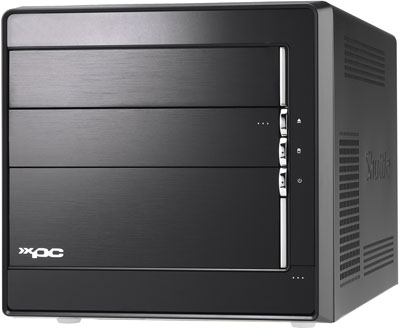This article is more than 1 year old
Shuttle XPC SN27P2 small form-factor PC
Build-your-own AMD Socket AM2 box
Review With the demise of Airfix, we blokes are left with few hobbies to pursue. Happily, we can still build our own PCs. If you want to work on the cheap you can use a beige tower, but should you fancy a modicum of style then there's no better starting point than a Shuttle barebone...

The Shuttle XPC SN27P2 is externally identical to the SD37P2, which we reviewed a little while back and measures the same 32.5 x 22 x 21cm, but internally the cooling system has been revised. Cooling in a small form-factor PC is no minor consideration, and that's especially true with the SN27P2, which uses a Shuttle FN27 motherboard with support for all Socket AM2 processors, including the Athlon 64 FX. In addition, you get four DDR 2 memory slots - for up to 8GB of RAM, ie. no more than 2GB per slot - and a proper PCI Express x16 slot that can accommodate a double-slot graphics card, provided you're prepared to sacrifice the adjacent PCI slot.
Shuttle provides a 400W power supply that includes a six-pin PCIe graphics connector so you've got all of the fundamentals that you need to build a full-on PC that just happens to fit into a small case. Getting inside the Shuttle to start your build is a breeze. Remove four thumb screws and the cover slides back and then lifts off, revealing the two hard-drive bays that live at the top of case. Each drive bay is secured to the top rails of the chassis with four screws and orients the drive across the case with one bay located behind the other.
It takes moments to remove the bay, install a drive and reinstall the drive bay. As the power and SATA cables are clipped into exactly the right position on the chassis rail it's a doddle to connect them up. These new drive bays are a relatively small change but they make a world of difference to the layout of the XPC. With the two hard drive bays removed you can pull out the combined optical and floppy drive bay, a process which effectively guts the case, laying all its secrets bare. We call it a floppy bay, but in the event that you choose not to install a floppy drive you could always fit a third hard drive which will suit fans of RAID 5.
At the back of the case you have the power supply which of course has a fan that draws air through the unit before it's expelled to the rear. Above the power supply there are dual 60mm fans that draw cooling air over the hard drive bays. Finally, we have Shuttle's own ICE cooling module on the processor. On one side of the cooler there's a 70mm fan and on the other you have a hinged 90mm unit that can be swung to one side in the event that you need to gain access to the fan headers on the motherboard. That's a great deal of cooling and while the fans are relatively quiet they nonetheless combine to produce a steady droning noise. Curiously, we found that the two ICE fans run at all times, even when the PC is shut down.
During the construction of our test PC with an Athlon 64 5000+, 2GB of Kingston KHX6400 RAM and a Western Digital 250GB hard drive, the only snag that we hit was when we tried to install an Asus 7600GT Top Silent graphics card. This uses a bulky passive heatsink which fouled against the Shuttle casing. Switching to a regular Asus 7600GT, the PC went together smoothly and we got on with the installation of Windows.
